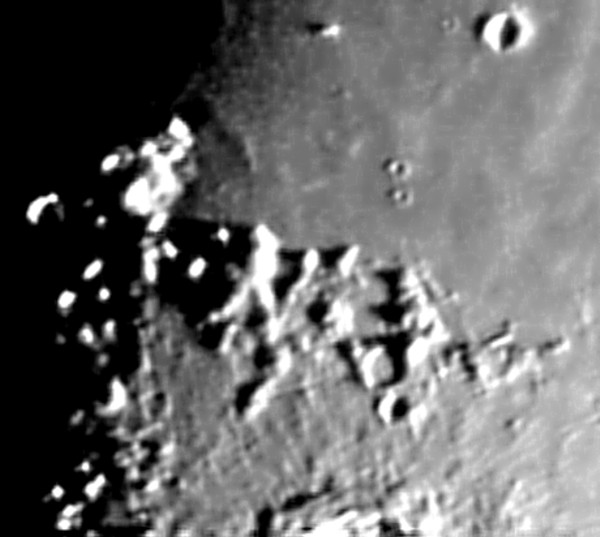Montes Carpatus
Contents
Montes Carpatus
(formerly Carpathians)
|
Lat: 14.5°N, Long: 24.4°W, Diam: 361 km, Height: 2.4 km, Rükl: 20 |

Comments on the above image:
This impressive mountain range north of crater Copernicus (officially known as Montes Carpatus) is a grand sight under low (local morning) light. Note the pronounced illuminated part which is unofficially known as Promontorium Banat ! (halfway between the frame's centre and its upper left corner).
Imaged through a 6" achromate with a 2X Barlow and LPI CCD camera. 50 stacked images. As a lunar observer since 1957, this range will always be the Carpathian Mountains to me.
- Gassendi- , and additional notes by - DannyCaes Sep 2, 2016
Additional note:
Do you also see this huge illuminated "N" in the photograph above? (an "N" shaped appearance in the Carpathian mountains).
- DannyCaes Sep 17, 2016
Images
LPOD Photo Gallery Lunar Orbiter Images Apollo Images
Maps
(LAC zone 58A2) LAC map Geologic map
Description
Description: Elger
(IAU Directions) THE CARPATHIANS.--forming in part the southern border of the Mare Imbrium, extend for a length of more than 180 miles westward of W., long. 16 deg., and, embracing the ring-plain Gay-Lussac, terminate east of Mayer. They present a less definite front to the Mare than the Apennines, and are broken up and divided by irregular valleys and gaps; their loftiest peak, situated on a very projecting promontory north-east of Mayer, rising to a height of 7,000 feet. Notwithstanding their comparatively low altitude, the region they occupy forms a fine telescopic picture at lunar sunrise.
Description: Wikipedia
Additional Information
Depth data from Kurt Fisher database
- Viscardy, 1985: 2.4 km
- Cherrington, 1969: 2.01 km
Nomenclature
- Named after the terrestrial Carpathians.
- According to Whitaker (p. 203), the name Montes Carpatus was used by J.Hewelcke (Hevelius) for the crater now known as Eudoxus.
- The name Carpathians, referring to the present lunar mountain range, was part of the original IAU nomenclature of Named Lunar Formations (1935). Who's Who in the Moon attributes the use of the term in this modern sense to Mädler.
- The name was Latinized to Montes Carpatus in IAU Transactions XIIB (1964).
- Called Montes Carpathus (with h) on Hans Schwarzenbach's moonmap of HALLWAG.- DannyCaes Oct 28, 2012
- There were many subdivisions in the Montes Carpatus which received all sorts of names from Johann Nepomuk Krieger and Rudolf König. Some of these were incorporated (with English spellings) in the 1935 IAU nomeclature of Blagg and Müller: Cape Banat (or Cap Banat / Promontorium Banat), Sinus Gay-Lussac, and Pietrosul Bay (or Pietrosul Bucht / Sinus Pietrosul). Others were not: Sinus Banat, Matra, Neutra, Cisneutra, Neutra Streifen, Tatra, and perhaps many more. The three names adopted by the IAU in 1935 were dropped in the 1960's, as were the subdivisions of Montes Riphaeus.
- It would be interesting to give the name Mons Gerlach (or Mons Gerlachovsky) to the highest peak in the Montes Carpatus, because on earth, the highest peak of the Carpathian range is also called the Gerlach Peak. - DannyCaes May 11, 2013
- Some of these names (for example: Cap Banat) were printed on classic moonmaps (one of those maps, the HALLWAG-moonmap by Hans Schwarzenbach, is a good start to look for non-I.A.U. nomenclature). Research: Danny Caes
- The western end of Montes Carpatus was called Montes Aerii by J.Hewelcke (Hevelius). See page 201 in E.A.Whitaker's Mapping and Naming the Moon.
LPOD Articles
Bibliography
- Subdivisions in Montes Carpatus:
MAPPING AND NAMING THE MOON, by Ewen A. Whitaker (page 226, Appendix N).
NAMED LUNAR FORMATIONS, by Mary Blagg.
OP ONTDEKKING IN HET MAANLAND, by A.J.M.Wanders (Het Spectrum, 1949). See Wanders's moonmap (the Fourth quadrant) for J.N.Krieger's and R.Konig's names Pietrosul baai, K.Banaat, and S.Gay-Lussac.
The (terrestrial) Carpathian mountains in slightly uncommon literature
Something for those who want to know more about appearances of unusual objects in earth's atmosphere, especially above certain parts of the Carpathian mountains in Romania (the Banat region):
Please search books written by Flemish author Julien Weverbergh and Romanian author Ion Hobana, because these books are extremely interesting, but... unfortunately neglected by truckloads of scientists and narrow-minded people.
- DannyCaes Sep 16, 2016